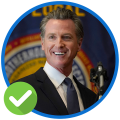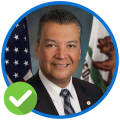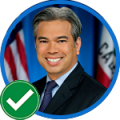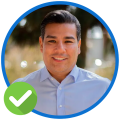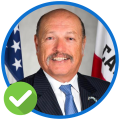Reelect Governor Gavin Newsom to keep California on the right track for progress.
Gov. Gavin Newsom’s track record and policy positions demonstrate that he will continue to be a progressive voice for the constituents of California and will govern effectively in the best interest of this diverse state.
Progressive endorsements: Gov. Newsom has the endorsement of many progressive groups in the state, including NARAL Pro-Choice, California Teachers Association, and California Labor Federation.
Top issues: Economic recovery and growth, health-care access, early-childhood education, police reform, consumer and worker protections, climate protections, statewide wildfire response, and reproductive choice.
Priority policies: Gov. Newsom’s priorities for California this term have included action on issues across the policy spectrum. On criminal-justice reform, he has paused executions across the state, and established new limitations on police use of force. On education reform, he has expanded early-childhood education to include four-year-olds, established updated standards and guidelines for charter schools, and provided free school meals to all public schools during the pandemic. On the economy, he has used federal pandemic money to provide the largest economic stimulus package in state history, and signed legislation that provided protections for individuals working in the gig economy. On climate protections, he has moved the state closer to an eventual full ban on fracking, and ordered a ban on gas-powered cars by 2035. Gov. Newsom has also advanced an executive order to use state agencies to store and remove carbon from the atmosphere, and to establish a first-in-the-nation goal of conserving 30 percent of the state’s land and coastal water by 2030. Gov. Newsom’s administration has expended significant resources for responding to some of the state’s worst wildfire seasons, and has worked with local governments as they pursue resolutions to the ongoing homelessness crisis across the state.
Gov. Newsom has failed to take strong action on several important issues, however, including replacing police with mental-health professionals, bringing new financial-reporting standards to public education, establishing a single-payer health-care system, and supporting safe drug-injection site pilot programs in the state. He has also been criticized for aligning with wealthy donors and special interests, including on some environmental policies.
Governance and community leadership experience: Gov. Newsom has served as governor since 2018, when he was elected with over 61% of the vote. In the fall of 2021, Gov. Newsom was the target of a recall campaign. The recall was backed by a right-wing coalition eager to capitalize on the perception of political weakness that had resulted from the ongoing economic impact of his response to the COVID-19 pandemic. The recall effort was unsuccessful, with 61% voting to retain Gov. Newsom. Running the special election a year ahead of the 2022 election cycle is estimated to have cost California taxpayers an additional $200 million.
Prior to his election in 2018, Gov. Newsom served in positions across state and local governments. He served two terms as lieutenant governor under former Gov. Jerry Brown, two terms as mayor of San Francisco, and two terms as a member of the San Francisco Board of Supervisors.
Other background: Gov. Newsom, a career public official, is from San Francisco.
The Race
Primary election results: The June 2022 results included incumbent Gov. Gavin Newsom (D), 56%; Brian Dahle (R), 18%; Michael Shellenberger (I), 4%; Anthony Trimino (R), 4%; Jenny Rae Le Roux (R), 4%; Shawn Collins (R), 3%; Luis Javier Rodriguez (I), 2%; and over 20 other candidates who each received less than 2% of the vote. Gov. Gavin Newsom and Brian Dahle will compete in a run-off in the November 8 general election.
Candidate fundraising and pledges: Gov. Newsom’s campaign has raised $19.8 million and is not funded by fossil fuel interests. He has received problematic donations from California Correctional Peace Officers Association PAC, 21st Century Fox American Inc., Google Inc., and Shorenstein Realty Services Inc.
Opposing candidate: Republican Brian Dahle
Opposing candidate’s fundraising and pledges: Dahle’s campaign has raised $1.7 million and is funded by police, real estate, and fossil fuel interests.
The District
State: California is the most populous state in the United States, and includes 58 counties and 331 million residents.
Voter registration: Of the 22 million registered voters in the state, 47% are Democrat, 24% are Republican, and 23% have no party preference. Democrats have held the lieutenant governor seat since 2011.
District demographics: 39% Latino, 16% Asian, and 7% Black
Recent election results: California voted for Joe Biden for president in 2020 by 29 points and Gavin Newsom for governor in 2018 by 24 points.
The Position
Governors serve as the chief executive officer of a state, and have the authority to sign and implement state laws. They are responsible for overseeing the operations of the executive branch of the state government, and advancing statewide initiatives and programs through executive orders, legislative proposals, or executive budgets. Governors have the exclusive authority to nominate or appoint officials, including agency heads, cabinet secretaries, and state court judges. Gubernatorial power varies across states, as each state government operates under the guidance of a state constitution.
Each governor is elected by popular vote in a statewide election. In California, governors are elected to serve a four-year term, and are limited to two terms in office.
Reelect Governor Gavin Newsom to keep California on the right track for progress.
Gov. Gavin Newsom’s track record and policy positions demonstrate that he will continue to be a progressive voice for the constituents of California and will govern effectively in the best interest of this diverse state.
Progressive endorsements: Gov. Newsom has the endorsement of many progressive groups in the state, including NARAL Pro-Choice, California Teachers Association, and California Labor Federation.
Top issues: Economic recovery and growth, health-care access, early-childhood education, police reform, consumer and worker protections, climate protections, statewide wildfire response, and reproductive choice.
Priority policies: Gov. Newsom’s priorities for California this term have included action on issues across the policy spectrum. On criminal-justice reform, he has paused executions across the state, and established new limitations on police use of force. On education reform, he has expanded early-childhood education to include four-year-olds, established updated standards and guidelines for charter schools, and provided free school meals to all public schools during the pandemic. On the economy, he has used federal pandemic money to provide the largest economic stimulus package in state history, and signed legislation that provided protections for individuals working in the gig economy. On climate protections, he has moved the state closer to an eventual full ban on fracking, and ordered a ban on gas-powered cars by 2035. Gov. Newsom has also advanced an executive order to use state agencies to store and remove carbon from the atmosphere, and to establish a first-in-the-nation goal of conserving 30 percent of the state’s land and coastal water by 2030. Gov. Newsom’s administration has expended significant resources for responding to some of the state’s worst wildfire seasons, and has worked with local governments as they pursue resolutions to the ongoing homelessness crisis across the state.
Gov. Newsom has failed to take strong action on several important issues, however, including replacing police with mental-health professionals, bringing new financial-reporting standards to public education, establishing a single-payer health-care system, and supporting safe drug-injection site pilot programs in the state. He has also been criticized for aligning with wealthy donors and special interests, including on some environmental policies.
Governance and community leadership experience: Gov. Newsom has served as governor since 2018, when he was elected with over 61% of the vote. In the fall of 2021, Gov. Newsom was the target of a recall campaign. The recall was backed by a right-wing coalition eager to capitalize on the perception of political weakness that had resulted from the ongoing economic impact of his response to the COVID-19 pandemic. The recall effort was unsuccessful, with 61% voting to retain Gov. Newsom. Running the special election a year ahead of the 2022 election cycle is estimated to have cost California taxpayers an additional $200 million.
Prior to his election in 2018, Gov. Newsom served in positions across state and local governments. He served two terms as lieutenant governor under former Gov. Jerry Brown, two terms as mayor of San Francisco, and two terms as a member of the San Francisco Board of Supervisors.
Other background: Gov. Newsom, a career public official, is from San Francisco.
The Race
Primary election results: The June 2022 results included incumbent Gov. Gavin Newsom (D), 56%; Brian Dahle (R), 18%; Michael Shellenberger (I), 4%; Anthony Trimino (R), 4%; Jenny Rae Le Roux (R), 4%; Shawn Collins (R), 3%; Luis Javier Rodriguez (I), 2%; and over 20 other candidates who each received less than 2% of the vote. Gov. Gavin Newsom and Brian Dahle will compete in a run-off in the November 8 general election.
Candidate fundraising and pledges: Gov. Newsom’s campaign has raised $19.8 million and is not funded by fossil fuel interests. He has received problematic donations from California Correctional Peace Officers Association PAC, 21st Century Fox American Inc., Google Inc., and Shorenstein Realty Services Inc.
Opposing candidate: Republican Brian Dahle
Opposing candidate’s fundraising and pledges: Dahle’s campaign has raised $1.7 million and is funded by police, real estate, and fossil fuel interests.
The District
State: California is the most populous state in the United States, and includes 58 counties and 331 million residents.
Voter registration: Of the 22 million registered voters in the state, 47% are Democrat, 24% are Republican, and 23% have no party preference. Democrats have held the lieutenant governor seat since 2011.
District demographics: 39% Latino, 16% Asian, and 7% Black
Recent election results: California voted for Joe Biden for president in 2020 by 29 points and Gavin Newsom for governor in 2018 by 24 points.
The Position
Governors serve as the chief executive officer of a state, and have the authority to sign and implement state laws. They are responsible for overseeing the operations of the executive branch of the state government, and advancing statewide initiatives and programs through executive orders, legislative proposals, or executive budgets. Governors have the exclusive authority to nominate or appoint officials, including agency heads, cabinet secretaries, and state court judges. Gubernatorial power varies across states, as each state government operates under the guidance of a state constitution.
Each governor is elected by popular vote in a statewide election. In California, governors are elected to serve a four-year term, and are limited to two terms in office.
